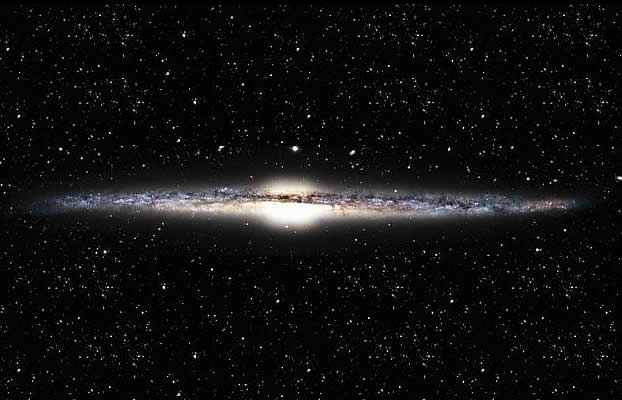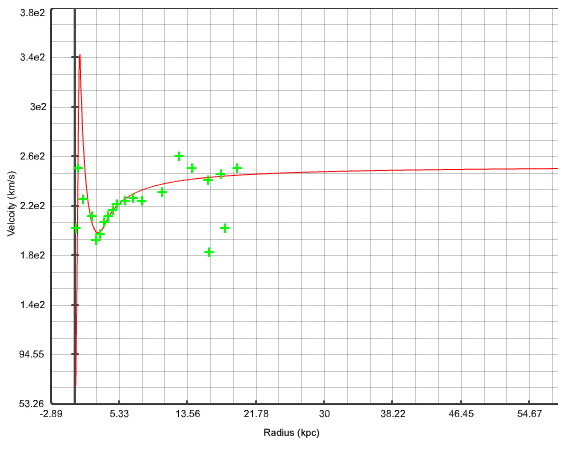Our Current Understanding of the Milky Way
Our current understanding of the Milky Way - its size, mass and composition represents the convergence of many critical ideas. Our knowledge of the large scale structure came through key developments in radio astronomy, understanding the nucleus combines radio, infrared an x-ray observations and measurements of the rotation of the galaxy reveal a deep mystery about the universe itself.
327-330
The Size of the Galaxy
Shapley's study of the distribution of globular clusters reveals that we are situated about 8.5 kpc or 25 000 light years away from the centre of the Milky Way. As you saw in the previous section, the Shapley-Curtis debate was resolved with the understanding that our galaxy is about 100 000 light years across and is one of literally billions of "island universes" or separate galaxies. Figure 12.10 presents a schematic diagram of a what we think the Milky Way would look like from a vantage point outside the galaxy.
 |
| Figure 12.10 Edge on galaxy NGC 4565. This is a galaxy that is what the Milky Way would look like from a distant vantage point. (Image courtesy of Canada-France-Hawaii Telescope / Coelum) |
While the galaxy is about 100 kly across it is only about 3 kly thick in all but the central nuclear bulge which consists of a spherical distribution of older stars and is about 6 kly in radius. Surrounding the galaxy is the halo. This is a vast region in which you find the globular clusters, very old stars and possibly large amounts of "dark matter". Table 12.3 summarizes some of the key properties of the galaxy.
| Mass | 0.93 x 1011 M0 (interior to Sun's orbit) |
| Diameter (disk) | 30 kpc |
| Distance sun-nucleus | 8.7 kpc |
| Orbital period of Sun | 2.5 x 108 a |
| Diameter Halo | 100 kpc (?) |
| Thickness of disk | 1 kpc |
| Number of stars | 4 x 1011 |
| Average stellar density | 20 stars/pc3 |
| Density of ISM | 10-24 g/cm3 (1 H atom/cm3) |
| Table 12.3 Basic properties of the galaxy. | |
The Mass of the Galaxy - and a Mystery
How can you "weigh" a galaxy? As difficult as it sounds the technique is relatively simple and rests on applying Kepler's Third Law of orbital motion. Using the Doppler effect as described in 6.3 and by collecting spectra (either optical or radio spectra) from different regions in the galaxy it is possible to measure Doppler shifts and hence velocity as a function of location in the galaxy.
As you learned in Chapter 4.3, Kepler's Third Law relates the period of revolution of a particle to its distance from the center of mass in a system. But Kepler's Third Law can be expressed in a different way - one in which velocity can be expressed as a function of distance from the centre of mass and the mass itself. By measuring how fast the sun is moving around the galaxy it is possible to determine how much mass must be within the Sun's orbit around the centre of the galaxy. The applet ![]() galaxyRotation given in Figure 12.11 shows actual data of orbital velocity in the galaxy to distance from the galactic centre.
galaxyRotation given in Figure 12.11 shows actual data of orbital velocity in the galaxy to distance from the galactic centre.
| Figure 12.11 |
Example 12.5 The Sun is located 8.5 kpc from the galactic centre and orbits with a velocity of about 220 km/s. Use the applet provided in Figure 12.11 to estimate the mass contained within the Sun's orbit.
Solution: By adjusting only the left-most sliders and setting an inner radius of somewhere around 0.92 kpc with a density of about 30(billion solar masses/cubic parsec) you will find that the mass inside the Sun's orbit amounts to approximately 100 billion solar masses. You can find many different radius and density combinations that will produce the correct orbital velocity for the Sun but in all cases the mass interior to the Sun's orbit will be on the order of 100 billion solar masses.
Example 12.5 points toward a mystery. Pioneering work done in the 1970's by the American astronomer Vera Rubin shows that the orbital velocities in most galaxies (including our own) are much too high! The problem is that if the mass in the galaxy was concentrated in the nucleus where we seem to see it then the velocity should drop off as you move outward from the centre. This is exactly what we observe in the solar system and astronomers call this kind of velocity behaiour "Keplerian Motion". In the galaxy however the velocity appears to remain rather constant and perhaps even rises are you move outward! This suggests that there is a lot more mass OUTSIDE the Sun's orbit.
Example 12.6 Recent findings suggest that the rotational velocity of the galaxy remains constant out to 50 kpc or more. Use the applet galaxyRotation to find a mass model for the galaxy that fits the data. From this determine a projected mass for the galaxy.
Solution: Unlike example 12.5 where it was possible to find many models that could reproduce the "one data point" of matching the Sun's orbital velocity to its location now you are constrained to fit the entire range of data points (shown as green crosses). This is shown below:
In this model most of the galaxy's mass lies outside the Sun's orbit and would appear to be "unseen". The set-up that produces this fit to the data implies that the total mass of the galaxy is approximately 800 billion solar masses. It seems that there is, literally, more to our galaxy than meets the eye! As much as 90% of the mass of our galaxy (and others) could be in a form of matter not visible to us and hence called Dark Matter. We will return to this topic in future chapters. |
 |
| Figure 12.12 Rotational model for the Milky Way galaxy |

To learn about our current understanding of the Milky Way
Chp 15.2
